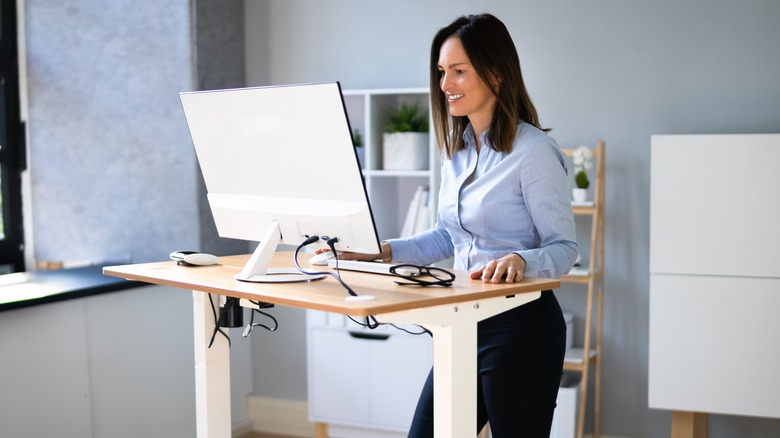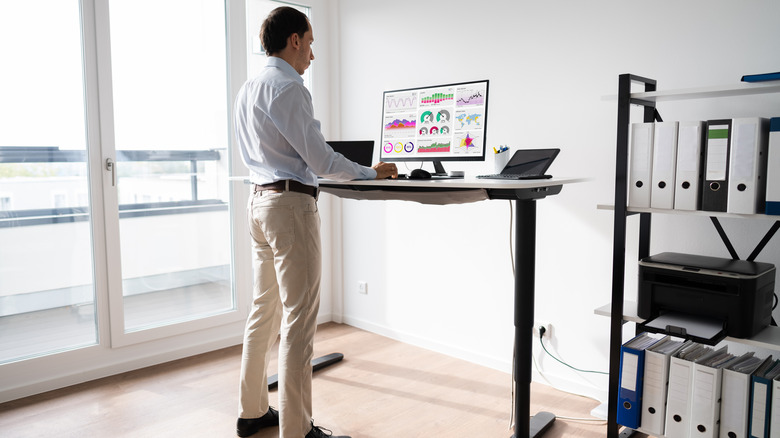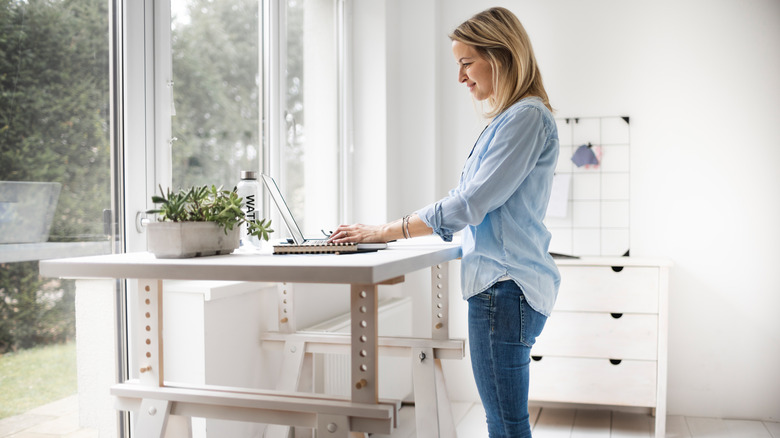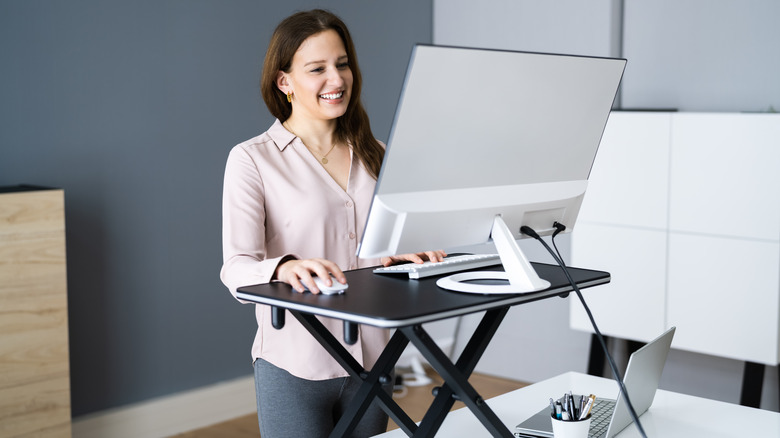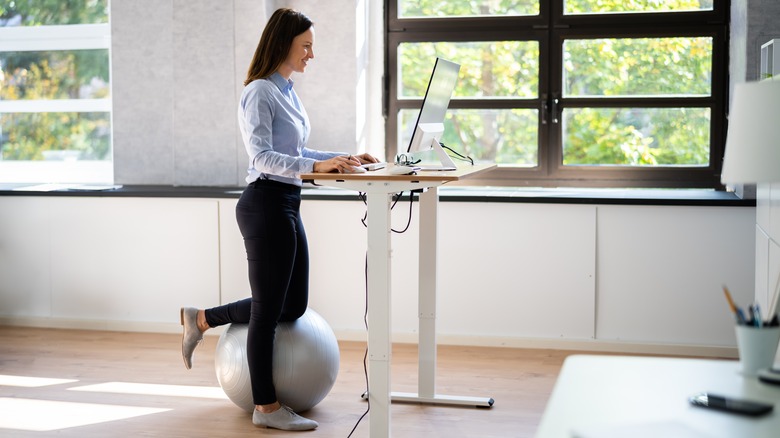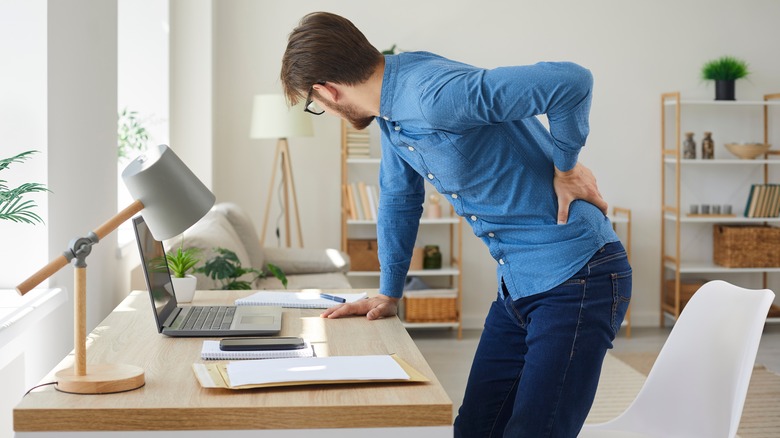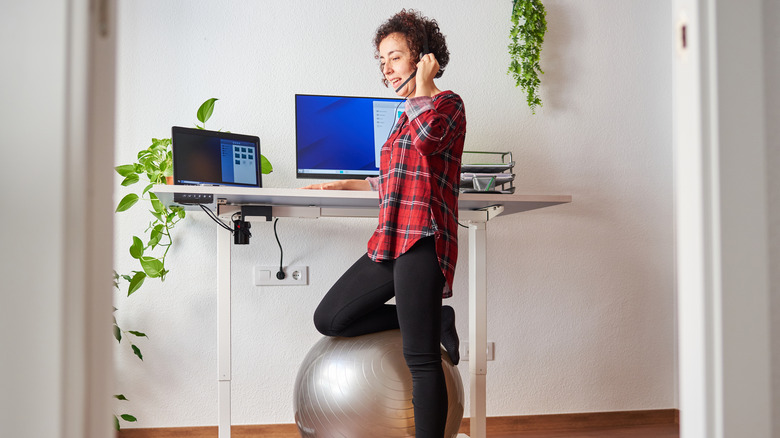Standing Desks: What To Know Before You Buy One
In the last couple of years, standing desks have become quite popular in workspaces and home offices. While brought on by the pandemic for many, standing desks had already caught the eye of a few companies and workers before the COVID-19 outbreak. The need to be more active during the work day, paired with the flexibility of standing while working, makes standing desks as practical as they sound. They've also been linked to a number of health benefits, like lowering the risk of heart disease, obesity, and back and neck pain, according to WebMD. Undeniably, anyone, no matter their age, level of activity, or anything else, can face health issues if they're sitting down, or sedentary, for too long.
Standing desks come with a lot of different features, with many models even adjustable to switch between standing and sitting throughout the day. Different standing desks are appropriate for different people and different situations, and we're here to help you choose the right one for you. When buying, there are a few things you'll want to keep in mind like cost, durability, mistakes to avoid, and some of the pros and cons of these new and trendy desks.
What is a standing desk?
Standing desks are pretty self-explanatory in that the name pretty much says it all. They are conceived for writing, computer work, drawing, and anything else you can do from a normal desk. The only thing that differs from a regular desk is that when using a standing desk — you guessed it, you are standing. You can also be on a high stool, but evidently, that's not the point. Ideally, a standing desk comes up to your elbows and if you are using a computer, the screen will be at eye level. A standing desk can be adjusted to your height once bought, per Wirecutter.
They are used for lots of different reasons and essentially can be for anyone who wants to switch up the way they work. Most people that look into getting a standing desk are usually just tired of sitting down from 9 to 5.
Recommended use
The use of standing desks is recommended for different reasons but they can essentially be beneficial to almost anyone. Students, for example, can benefit largely from standing desks as they're very often — and for the majority of their day — already sitting at their desks at school. Learning in a classroom environment, students can easily be sitting for eight hours a day already. If they have to add four to five more hours to that for homework and studying, sitting time for students could increase to more than 12 hours a day, which is why a standing desk to at least do homework could be a way to go.
Additionally, standing desks are a good option for artists and designers, according to Updesk. Artists and designers usually have a lot of material to work with and often need to walk around; if they're already standing, this can make things easier for them versus constantly getting up and sitting back down. These types of jobs also don't always have hours like a 9-to-5 job so people in these fields could end up working over 10 hours a day, which would be a long time to be sitting down.
A company as a whole could also benefit from getting ergonomic standing desks for their employees. Although office jobs don't typically have you sitting for more than eight hours a day, a call-center study published in the journal IIE Transactions on Occupational Ergonomics and Human Factors found that employees who used standing desks were 46% more productive than those sitting at traditional desks. As a company, this could be a great way to boost productivity levels.
What are the different types of standing desks?
Although standing desks are all relatively the same, some features do set them apart from each other. First of all, we have the regular manual standing desk, which can be adjusted to different heights manually. It's not the most practical of designs, especially if you tend to have a lot on your desk, but it gets the job done. Electric standing desks, meanwhile, can be adjusted with the push of a button, as explained by ergonomic furniture supplier Ergolink.
Standing desk converters aren't desks, per se, but they can quickly turn your traditional desk into a standing one — similar to a riser for your monitor. Finally, and this one is almost in a category of its own, there are treadmill standing desks today, which, on top of being a standing desk, also works as a treadmill.
Further, it's important to note that fixed standing desks do exist but as indicated by the name, they're not adjustable and therefore not the best option as you won't be able to switch from standing to sitting and will also not be able to adjust it to your specific height.
How to choose the right one for you?
The standing desk you choose is ultimately up to you but can differ depending on what you'll be using it for and what kind of life you lead. Treadmill desks, for example, are without a doubt not for everyone. Walking and working can be distracting for some people or even just too tiring if you aren't the athletic type.
If you're on a budget and already have a regular desk, you might want to go with a converter instead of buying a whole new desk. On the other hand, if you do want a real standing desk, your choice is between the manual and the electric, and it's going to come down to whether or not you keep a cluttered desk. If you do, the best option is going to be the electric standing desk but if you don't have anything more than a laptop, a manual one can work great.
The latter does require more effort to bring up and down, points out Autonomous. Keep in mind that since it's important to maintain a healthy balance of sitting and standing time, you'll be bringing your desk up and down quite regularly.
What are the pros and cons?
In terms of pros, standing desks offer a fair share, mostly with regards to health benefits. According to Healthline, standing desks can you help burn more calories during the day, improve your posture, and consequently reduce back pain related to sitting. The outlet also notes that working from a standing desk can help improve energy levels and motivation.
In regards to motivation, Andy Stern's Office Furniture notes that this could be tied to whether or not the standing desk was provided by a company or not, and if the standing desk was the result of a push by the company to make more ergonomic equipment available to its employees.
On the other hand, standing desks do have you on your feet for a majority of the day and although sitting for prolonged periods of time isn't good for you, standing for too long isn't either, as it can cause muscle pain and fatigue. Additionally, although standing desks do have health benefits, they might not be as impressive as they sound.
In a conversation with Wired, Peter Smith, a senior public health scientist from the Institute of Medical Science at the University of Toronto, explains that "[i]f you were to stand instead of sit for an hour, you would burn nine extra calories. You would need to stand for six hours more to burn off the energy from a slice of bread. And standing for that long will put you at risk for other conditions like heart disease."
Standing desk mistakes to avoid
There are a few mistakes to avoid in order to have a good experience with your standing desk. Firstly, and as we've already noted, it's important to alternate between sitting time and standing time, as standing still for too long could lead to problems just as well. Try to move around when you have the chance; Verywell Fit, for example, recommends walking in place while working from your standing desk.
Additionally, you want to avoid setting your standing desk too high or too low to limit back pain; remember, your computer screen or monitor should be set at eye level. Further, to avoid discomfort in your feet or legs, be sure to also invest in an anti-fatigue mat. Standing on a hard surface would be a mistake even if you only choose to stand 20 minutes at a time at your standing desk, according to Autonomous.
How much do they cost?
If you've decided you want to take a stand (literally), price will be, of course, a consideration. On average, a standing desk will set you back around $1,000, depending on the model. However, prices can be as low as $300 to $400; on the high end, standing desk prices can reach the $2,000 to $3,000 range.
Clearly, a standing desk converter will be the cheapest option, followed by a fixed standing desk, then a manually adjustable standing desk; electric standing desks are among the most expensive.
If you want to try working from a standing desk before making a big-ticket investment, a standing desk converter would be your best path, as you can get one of these table-top additions for as little as $100, according to The Standing Desk. A good quality manual standing desk will cost you around $500, while an electric standing desk can easily cost $1,000.
